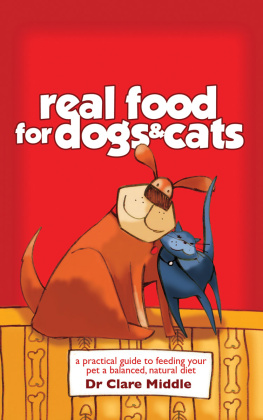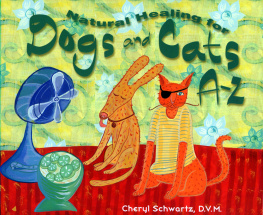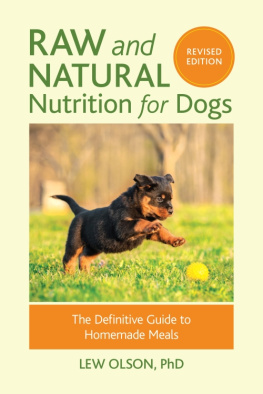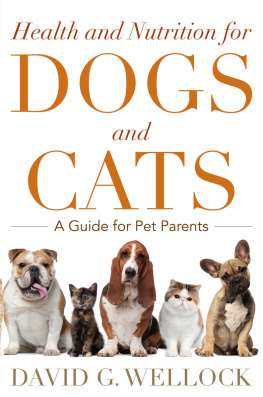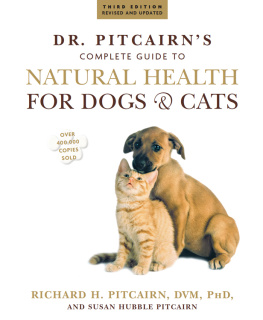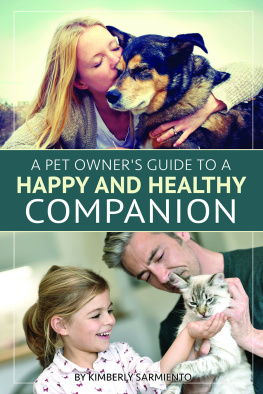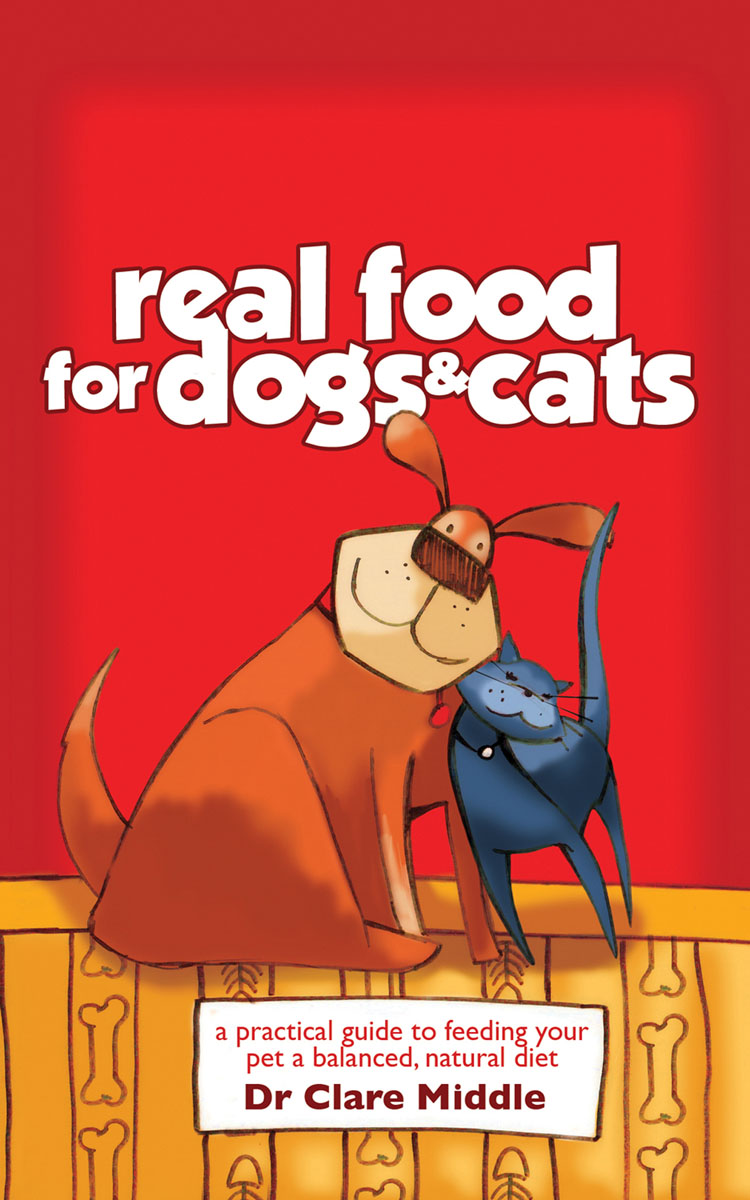

First published in 2008 by
FREMANTLE PRESS
25 Quarry Street, Fremantle 6160
(PO Box 158, North Fremantle 6159)
Western Australia
www.fremantlepress.com.au
Reprinted 2010, 2011, 2013, 2015.
This ebook edition first published in 2015.
Copyright Clare Middle, 2008
This book is copyright. Apart from any fair dealing for the purpose of private study, research, criticism or review, as permitted under the Copyright Act, no part may be reproduced by any process without written permission. Enquiries should be made to the publisher.
Editor: Janet Blagg
Design and illustrations: Tracey Gibbs
National Library of Australia Cataloguing-in-Publication entry
Author: | Middle, Clare (Clare Elizabeth) |
Title: | Real food for dogs and cats : a practical guide to feeding your pet a balanced, natural diet / Clare Middle. |
ISBN: | 9781925163681 (ebook) |
Subjects: | DogsFood. CatsFood. DogsNutrition. CatsNutrition. DogsFoodRecipes. CatsFoodRecipes. PetsFeeding and feeds. PetsFeeding and feedsRecipes. |
Dewey Number: | 636.7084 |

Fremantle Press is supported by the State Government through the Departent of Culture and the Arts.
Contents
Index
In memory of my parents
John and Ethel Horner,
specialist librarians,
who instilled in me a love
of independent and
open-minded investigation
How to use this book
on the components of a natural diet for dogs, which has much more detailed information relevant to both dogs and cats.
There is a lot of information in this book if you should need it, but reading the first section of is a very good summary and almost all you need to know!
The purpose of this book
In twenty-five years as a veterinarian I have explained the principles and benefits of a natural diet to most of my clients as part of their pets treatment program, and have given out thousands of copies of my brochure Natural Diet for Dogs and Cats. Many more have been read or downloaded from my website or passed on by clients to other pet owners.
Over the same time I have had many happy reports from dog and cat owners on the rapid improvements in their pets behaviour and health problems following the change from commercial processed pet food to a balanced, primarily raw, natural diet. However for many people the brochure did not contain enough information, and there were still many questions left unanswered.
So here is the book you asked for.
This book provides dog and cat owners with what may be the most important healing tool for the animals under their care an understanding of the physiological basis for a natural diet as close as possible to the diet for which nature equipped them and the simple steps to achieve this.
We are increasingly discovering that fresher, more natural whole food is important for our own long-term health. Similarly, feeding your animals the diet nature intended is likely to be the best way of keeping them happy and healthy. And as an added bonus, it is more economical than a premium quality commercial dried dog or cat food diet.
Clare Middle
BVMS, CVA, Cert IAVH
June 2008
Foreword
The widespread introduction of grain-based, cooked and processed pet foods which followed the Great Depression of the 1930s, ushered in two co-dependent eras; the era of artificial foods for companion animals and the era of modern companion animal medicine and surgery.
The convenience of processed pet foods has, since the 1930s, allowed companion animal numbers to rise dramatically; however, it has done so at enormous cost. Cooked and processed pet foods have brought with them an alarming escalation in complex medical and surgical problems, including hip and elbow dysplasia. Modern convenience foods provide the ideal biochemical and physiological milieu for the development of a whole range of degenerative conditions veterinarians treat daily and, unfortunately, these processed foods, based principally on carbohydrates, continue today as the mainstay of modern companion animal nutrition.
The animals forced to eat these foods become increasingly plagued by problems such as arthritis, inflammatory bowel disease, epilepsy and cancer.
In response to the enormity of these problems, the veterinary profession has developed sophisticated drugs and surgical approaches which rival those used to treat similar human conditions (with disturbingly similar causes).
However, cracks in this now universally accepted approach to companion animal practice (sitting squarely on the foundation of inappropriate nutrition) appeared in the early 1990s with the formalisation of raw feeding for dogs in my book Give Your Dog a Bone. This book, aided by the coincidental information explosion of the world-wide web, was the catalyst for a natural feeding movement for companion animals, a movement which gains momentum daily and reveals startling health improvements associated with biologically appropriate nutrition. This approach to health may already outperform much of modern medicines sophistry.
Dr Middle is among a small number of Australian veterinarians who have since written books validating biologically appropriate nutrition and recommending balanced whole raw foods, and I am delighted by this significant advance within our profession. For those requiring an insight into an approach to raw feeding as presented by an Australian holistic veterinarian, let me recommend this book most strongly.
There can be little doubt that the solution to the health problems assailing modern pets lies ultimately in their return to a more natural diet. This book will help continue the forward march of balanced, whole, raw foods as the gold standard approach to the health of todays companion animals.
Dr Ian Billinghurst
BVSc (Hons), BScAgr, DipEd
Veterinary surgeon, acupuncturist, and author of:
Give Your Dog a Bone
Grow Your Pups with Bones
The BARF Diet
Preface
I have known and worked with Clare since the early 1990s.
Two awkward questions are never far from her lips when she is working: Why? and How?
Like many holistic veterinarians I have spoken with, she has specialised in holistic medicine because too many questions are left unanswered by allopathic (orthodox or Western) medicine. Looking at alternative perspectives on health and adhering to the principle, First do no harm, holistic medicine enables the practitioner to more than double their therapeutic toolbox.
One major difference between current allopathic and holistic perspectives is the perception of health. Allopathically, we tend, with some exceptions, to come in at the end point of a disease process, intervening at the stage where clinical symptoms are present and disease is well established in the body. At this point we are treating hip dysplasia, diabetes, renal disease, cancer, etc. The disease process has a clear head start on therapeutic management.
Next page
